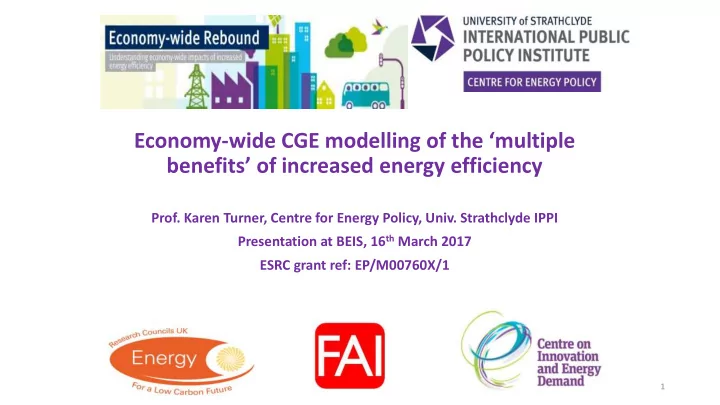

Economy- wide CGE modelling of the ‘multiple benefits’ of increased energy efficiency Prof. Karen Turner, Centre for Energy Policy, Univ. Strathclyde IPPI Presentation at BEIS, 16 th March 2017 ESRC grant ref: EP/M00760X/1 1
EPSRC EUED project ‘Energy saving innovations and economy - wide rebound effects’ http://cied.ac.uk/research/impacts/energysavinginnovations Project partners: EUED CIED centre at Sussex and Fraser of Allander Institute; external collaborators on different WP 2
In Introduction • Real focus of project: how does the wider economy respond to improvements in energy efficiency? • Not just energy use across the economy (rebound question) but activity levels, incomes etc. • ‘Multiple benefits’ (International Energy Agency, 2014) argument • Considering both industrial energy efficiency – stimulus to competitiveness • And household energy efficiency – demand-driven stimulus • Efficiency in the delivery of energy-using services 3
Modelli ling rebound an and multiple benefits usi sing CGE models • Multi-sector economy wide computable general equilibrium models are the most commonly adopted method for considering economy-wide rebound • Ex ante – ex post (historical) analyses often conducted using econometric methods • Key benefit of CGE – focus on causal process, importance of interactions between sectors and markets • Assess in context of wide range of economic and energy use impacts • Distributional impacts where identifying different household income groups • And also across different productive sectors/industries • Useful for ‘multiple benefits’ context that may concern policy 4
A A useful poli licy perspective? • Primary aim of energy efficiency policy is to reduce energy use and emissions • But wider policy environment and multiple objectives • Impacts on economic and other variables may be key in gaining support for energy efficiency 5
CGE modelling • Multiple sectors and markets • ‘General equilibrium’ • Options regarding specification and model ‘closure’ • Aim of CGE modelling should be comprehension – not “black box” • HM Treasury use of CGE modelling • National ‘tax model’ may be developed for energy issues – and/or international trade model……use of latter dominant at present 6
Our UK CGE model • Multi-sector economy-wide CGE model of the UK national economy • 2010 social accounting matrix • Around 30 production sectors producing 30 outputs • KLEM production functions – energy a distinct type of input (not HMT) • Government budget can be constrained or not, expenditure/tax exogenous or endogenous • Competitive goods markets • Two exogenous regions – rest of the Europe (REU) and rest of world (ROW) • UK and REU/ROW products imperfect substitutes (Armington assumption) and export demand responds to changes in prices 7
An Anticipated im impacts of f in increased efficiency in in household en energy use • Household energy efficiency: lowers marginal cost of energy services • Frees up income to spend on other things • Shift in pattern of, and increase in level of demand • Process of demand-driven economic expansion 8
Improving household residential energy efficiency 9
Improving household residential energy efficiency 10
All ll hou household case – whi hich ind industrie ies win in and and los lose? 11
12
An Anticipated im impacts of f in increased efficiency in in in industrial l en energy use • Industrial energy efficiency: lowers marginal cost of energy services • Decreased cost of production: may reduce output price, boosting economic productivity and competitiveness • Both in sector where efficiency improves and downstream • Process of productivity-led or cost-push economic expansion 13
5% Energy efficiency improvement: example of 2 energy-intensive sectors Rubber, Cement, Glass Paper and Printing Short-Run Long-Run Short-Run Long-Run GDP 0.014 0.022 0.008 0.014 Consumer Price Index 0.003 -0.005 0.001 -0.005 Unemployment Rate -0.077 -0.164 -0.045 -0.108 Total Employment 0.005 0.010 0.003 0.007 Real Gross Wage 0.008 0.016 0.005 0.011 Investment 0.034 0.017 0.022 0.012 Government Deficit -0.053 -0.101 -0.032 -0.067 Exports to EU 0.013 0.028 0.002 0.011 Exports to ROW 0.002 0.019 -0.001 0.010 Energy use in UK production sectors -0.094 -0.101 -0.057 -0.061 Total energy use in the UK -0.064 -0.070 -0.039 -0.042 Capital Stock of Coal Extraction sector Fixed -0.142 Fixed -0.060 Capital Stock of Electricity sector Fixed -0.042 Fixed -0.038 14 Capital Stock of Gas distribution sector Fixed -0.110 Fixed -0.050
5% Energy efficiency improvement: example of 2 non energy-intensive sectors Manufacture of Motor Vehicles, Trailers and Semi Trailers Construction - Buildings Short-Run Long-Run Short-Run Long-Run GDP 0.003 0.004 0.006 0.008 Consumer Price Index 0.000 -0.001 -0.001 -0.003 Unemployment Rate -0.017 -0.029 -0.023 -0.035 Total Employment 0.001 0.002 0.001 0.002 Real Gross Wage 0.002 0.003 0.002 0.004 Investment 0.005 0.002 0.011 0.003 Government Deficit -0.009 -0.016 -0.017 -0.023 Exports to EU 0.007 0.010 0.003 0.006 Exports to ROW 0.003 0.006 0.002 0.005 Energy use in UK production sectors -0.024 -0.028 -0.059 -0.072 Total energy use in the UK -0.016 -0.020 -0.041 -0.052 Capital Stock of Coal Extraction sector Fixed -0.022 Fixed -0.048 Capital Stock of Electricity sector Fixed -0.023 Fixed -0.060 15 Capital Stock of Gas distribution sector Fixed -0.021 Fixed -0.021
Conclusions • Analysis needs to be done on case-by-case basis • Economy-wide impacts depend on nature and focus of efficiency improvement, economic structure and conditions • For comprehension, need to build up layers of complexity • Simple examples presented here: project has involved, and ongoing work involving, developments in model specification and simulation strategies • ‘Learning by doing’ – for modellers and audience • Potential here for EPSRC Impact Accelerator with BEIS as partner 16
Recommend
More recommend